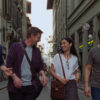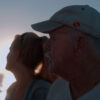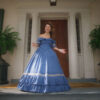If Sarah (Cristin Milioti) and Nyles (Andy Samberg), the protagonists of “Palm Springs” find themselves contemplating a moment that will never end — stuck at the wedding of Sarah’s sister (Camila Mendes) where neither wants to be when Nyles was dragged by his girlfriend (Meredith Hagner) who he suspects has been unfaithful and Sarah can feel the disappointment of her father that she isn’t married before her younger sis — Quyen Tran was constantly worrying that she wouldn’t have enough time.
The wickedly talented director of photography was already feeling the heat during a shoot in the desert. Largely constrained to a limited amount of locations for the story of a day that could last an eternity for Sarah and Nyles when at least one of them is revealed to be stuck in a time loop, she only would have three weeks to shoot such a complicated film where variations on the same scene would need to be captured from multiple angles and eventually different points of view. Still, Tran and director Max Barbakow could have a certain amount of confidence with a rigorous shot list that would leave nothing to chance and a knowledge that the DP with the knack for elegant camerawork on quick set-ups could figure it out with a crew that was just as invested as she was.
“A lot of that is just surrounding yourself with the best people and people that are really passionate about the project,” says Tran of the run-and-gun indie shoot. “I probably went into debt on this movie buying my crew dinners because we were staying out at this hotel in Palmdale, [which is] time away from family, but it was a very memorable experience. When you [primarily] work in the TV or studio system, you don’t really have those opportunities as much, and it’s fun every now and then to go away to camp and have these experiences with your crew.”
Tran had just wrapped the acclaimed Netflix drama series “Unbelievable” when the opportunity of “Palm Springs” arose, and as with her previous foray into comedy with Jeff Baena’s “The Little Hours,” the cinematographer who forges such a close connection between characters and her camera proves to be an inspired choice when the film makes the most of its clever premise, both in the slight surreality that sets in as Sarah and Nyles begin to go stir crazy and the way a couple’s vision of the world can align so strongly and diverge over the course of a long-term relationship. Accentuating the inherent brilliance of what Barbakow conceived with writer Andy Siara, the cinematographer creates a zesty, dynamic aesthetic that makes it feel like even when the characters in “Palm Springs” tire of looking at the same old same old, you’re seeing something fresh in every shot.
With the film arriving on Hulu after a triumphant premiere at Sundance earlier this year, Tran reflected on the comedy that now seems ahead of the curve when the coronavirus has left many losing all sense of time while in quarantine and she spoke of how she brought an irresistible visual variety to it and how besides bringing some much needed joy into the world with “Palm Springs,” she’s been using the time away from a film set to help others. [WARNING: Spoilers about “Palm Springs” ahead have been blurred and can be clicked on to unblur.]
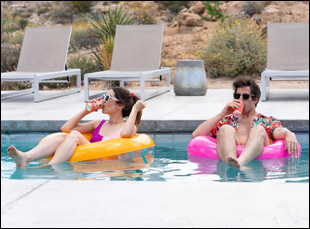
I was actually attached to another movie, a studio project, which fell through at the last minute and the day it fell through, my agent gave me “Palm Springs” and said, “Hey, this is a super tiny movie, but it’s a really special script and [the filmmakers] wanted to meet with you.” So I read it immediately and I fell in love, but I thought “This movie is insane. What is the budget? [laughs] Really? They want to make this film for how much? How?” But the script is so incredible and I just loved my meeting with Max Barbakow, the director, and knowing that Andy Samberg and Cristin Milioti were attached as well, I knew I wanted to be a part of it, so I was like dude, I cannot pass this movie up.
Beyond whatever budgetary concerns they were, did the challenges of actually filming this stand out when there must be so much repetition involved?
Yeah, when you see that two of your main locations are bedrooms, initially you just want to run away because with any interior where there’s a lot of page count, it can be really redundant and claustrophobic. But in this case, the claustrophobia aspect of it was appropriate because these two characters wake up in the same place day in and day out, so what Max and I tried to create was something interesting enough that could potentially tell a different kind of story every time they woke up and have a build up in the visuals [where] we would find new angles and add movement as the story progressed and the love between Sarah and Nyles became stronger.
We would echo that visual [in the bedroom] symmetrically, so say Nyles is looking at camera right when he wakes up and Sara is looking camera left, I tried to match the frames so that it looked like they were looking at each other on opposite sides of the bed. Everything was very planned out because the movie is told from two different perspectives – from Nyles’ and Sarah’s, so when Sarah enters the time loop, we need to reshoot everything and show it again through her eyes, and essentially we had to shoot scenes several times to show the different points of view, which was very challenging because of the given restraints on time [in our schedule].
Every angle had to have a meaning and it’s very intentional. For example, the one time that Sarah wakes up and she turns over, we cross the line and then we’re on the other side of her, against the window so she’s silhouetted, and in the background, the person that she’s having an affair with comes in and that’s the big reveal, so we were very intentional of what side of the line we were on for what scenes and as the film progresses, we get deeper and deeper into the mindset of these two characters so then we start to do slow push ins and we start to do extreme closeups where we didn’t before.
When it is only a handful of locations, were they set before you came onboard or did you have a hand in picking them out?
I very much had a say in the location and it kind of became a joke because when we went and scouted Palm Springs, nothing is shot in Palm Springs — [maybe] on the edge of Palm Springs and Yucca Valley, but it’s just ironic. It took us pretty much the whole prep time to lock in locations. We scouted Palm Springs, we scouted Lancaster, Palmdale, Palm Desert and we just couldn’t find a space that was big enough. We did find that one hero pool and we had to try to make that look like Palm Springs, but that was a space that was big enough to allow for a technocrane and for a crew and for the underwater work, and the light was good, but even then, as we started shooting, we hadn’t locked in all the locations because it was just really hard to find a rock formation that would allow Andy [Samberg] to stand up there and have the big rock behind him and find an opening for a cave [where Sarah and Nyles go] that would match the interior of the cave. It was very tricky, but it’s all about finding the locations to suit the story.
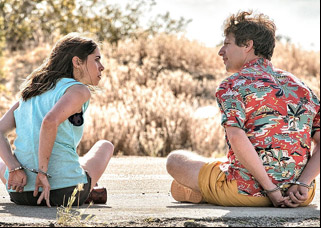
100 percent. I used my Sun-Seeker and I would draw out all my plans because a lot of times we only had three hours and then we had to do a company move, so working with Max and the AD, we would say, “Okay, we want to be on this part of the highway from 4 to 7” and then that’ll take us from this location, which we want to shoot in here and here. It was very carefully mapped out, especially with the pool scenes because I wanted to shoot techno with these overhead shots where at this hour, we won’t see the shadow of the crane on the pool, and then [we had] the underwater work [where] Andy’s going to be wet, so we had to make sure there’s enough time to reset after we shoot all of the dry stuff. It’s a lot of coordination, but I had such an outstanding crew and camera operators, I could focus more on the creative and not worrying about buzzing a take. For example, we were pretty much able to capture a lot of our underwater work on the first take because I had Bob Settlemire, who’s an incredible underwater DP/operator who just nailed it every take, and Chad [Persons], who’s such an expert with the steadicam and technocrane. I pulled from my TV crew and they are used to working really quickly and on the fly, which is exactly what we needed for this project.
This strikes a wonderful balance of accentuating its surreal premise while staying grounded and even if it’s subtle, this seems like the most heightened reality you’ve created on screen visually, particularly with the color palette. Was that exciting for you?
Yes, when we were designing the cave, we did not have a VFX person, so we were like, “We hope this works out.” [laughs] What we wanted to do was actually put up little LED lights, but the location didn’t allow us to put the lights up on the cave, so we [thought], hopefully add those twinkles in VFX, but what we were very specific about was the color orange and what [role] that played throughout the movie. Working with production designer Jason Kisvarday and Max, we created this orange theme that would only appear three times in the movie. That’s really where Sara and Nyles connect and demonstrate their love for one another – one is the cave, one is the firelight of the campfire and one is the tent, so we wanted to really make those moments special and have that color exist only for those key times.
And when Nyles and Sara are trapped in this very stagnant world, it’s only when they start to explore outside of the wedding venue that their worlds really open up, not just figuratively, but physically as well, so we were interested in these landscapes outside the wedding venue and we really wanted to introduce motion, so the camerawork becomes very fluid, very handheld. A lot of those scenes are improvised. For example, the tattoo scene, we were like, “Let’s just get it” and I shot that very documentary, verite style, but that was okay for that because these two people are discovering one another, they’re discovering how to live within the confines of this new world, and we wanted the camerawork to be visceral and exploratory as well.
The shot I’ve been wondering about since I saw it at Sundance was Nyles’ initial introduction to Sarah where he makes his way across the dance floor in a fluid take where he fools around with every wedding guest. It does cut back to show Sarah’s reaction, but how did you craft a shot with all that zipping and zagging that Nyles is doing?
Oh my gosh. My steadicam operator, who I’ve been working with for five years, is actually a champion swing dancer, and he’s this big guy — 6’3” or something and a big teddy bear — but he’s light on his toes. I’m so thankful because he just watched the choreography and was like, “Ok, I got it, I got it,” and we just came up with that. We choreographed [the camera moves] and it just worked out.

Yeah, it’s just been so great. I’m so grateful because “Unbelievable” is getting the recognition that I think that story deserves, which I’m so proud to have been a part of that team, and I’m really excited about “A Teacher” coming out and “Palm Springs,” of course. But I think with [along] the rest of us in the arts, it’s a very trying time because no one’s worked since March. I was in New Zealand on a feature film with Espen Sandberg called “The Beast” and we were three weeks away from camera when we were pretty much ejected from the country because of the coronavirus.
That was before the majority of production shut down — it was early March and we were all shocked [because] there were no cases in New Zealand, but the studio just had the foresight and thank God they did because I can’t imagine being quarantined in New Zealand and not knowing what was happening with my family in the United States. Big picture, we have to all stick together and be grateful for the careers and lives that we lead, and I hope that we’re able to return in a safe manner.
And I’ve heard you’ve been staying busy with a very worthwhile endeavor — tell me about “Bake It Til We Make It”?
So my dear friend [and fellow director of photography] Jeanne Tyson and I have been organizing family friendly protests and events that are COVID safe. She, like myself, is an avid baker, so we decided to team up for a fundraiser to benefit LA Food Bank. The other day my daughter, who shares a birthday with Jeanne, was asking if we could bake for the less fortunate, so here we are! We have already received an overwhelming response to the bake sale, and have nearly surpassed our goal, so I definitely see more bake sales in the near future, and until we make it back to our jobs as cinematographers. In the meantime, we’ll just bake it til we make it (back to set).
For more information on “Bake it Till We Make It,” you can follow DoughRectors of Photography on Instagram – as well as Jeanne Tyson and Quyen Tran. And “Palm Springs” is now streaming on Hulu.
